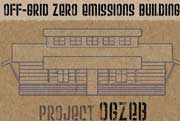
A brand is born
A house being built at the behest of Florida State University (FSU) that incorporates hydrogen, solar and fuel cell technology is set to be wholly energy self-sustainable. It is following in the footsteps of the famous BedZed development in London by architect Bill Dunster – see his forthcoming book available on Amazon: From A to Zed: Realising Zero (Fossil) Energy Developments
The Off-Grid Zero Emission Building (OGZEB) is being overseen by FSU’s mechanical engineering professor, Anjaneyulu Krothapalli of the Sustainable Energy Science and Engineering Center (SESEC). “We are building a house that’s not connected to the grid, completely run by solar during the day, and the house during the night will be run on hydrogen,” he explained.
FSU provided $200,000 to fund the project, with private partners including Mad Dog Design and Construction offering additional support. The house is due to be completed in December. However, a shortfall has been reported and FSU is looking for more investors. We decided to get involved.
Technology used in the house includes a device that makes hydrogen using solar energy and an innovative new fuel cell – both of which are currently awaiting patents.
The interior has also been designed by FSU, with sustainable materials including bamboo in the construction.
A 1000 square foot building, the OGZEB will be partitioned so that 750 square feet will be a two-bedroom, graduate style flat with the remaining 250 square feet serving as office space. It’s meant to serve as an energy efficient model for campus designers in student living and office space, and a prototype for developing and implementing new alternative energy technologies in residential and commercial settings.
To supplement the solar power generated, excess energy will be produced to provide energy storage allowing power to be continuously supplied to the house during non-daylight hours. The most common solution is the use of high efficiency batteries for energy storage. This approach has been, and continues to be, the de facto solution used by the teams in the Solar Decathlon. However, high efficiency batteries are extremely expensive and have a limited lifetime the OGZEB will use excess energy from solar panels, to produce hydrogen through the use of a highly efficient water electrolysis device currently being developed at SESEC. This hydrogen will be stored until it is required, at which time it will be fed to a special fuel cell (also being developed at SESEC).
The project won’t be the first to use hydrogen as an energy storage medium, but it will be the first to employ these particular designs that aren’t currently commercially available.
The hydrogen will also be used to address the biggest consumers of energy in a building: space heating, cooling and the generation of hot water. Through combustion in a furnace, the hydrogen will provide sufficient heat for space heating and will also generate enough heat to use advanced ammonia absorption technology for air-conditioning. The hot water will be generated through the use of an on-demand hot water heater that will be modified to use hydrogen as its working gas.
The use of hydrogen in this way is unique to the project, which is sort of test-run for all the new technologies under development for example, using an ammonia absorption cycle is also an original concept, especially for a small building.
The OGZEB will include low energy, spectrally selective windows, LED lighting, low air infiltration and extensive use of passive solar heating.
The design and construction of the OGZEB are also environment-friendly. The designers have tried to build the home with recyclable materials that are not detrimental to the environment during their creation and use.
The design and construction of the OGZEB will be guided by the LEED (Leadership in Energy and Environmental Design) Green Building Rating System, developed by the United States Green Building Council (USGBC/www.usgbc.org). The LEED system emphasizes state-of-the-art strategies for sustainable site development, water savings, energy efficiency, materials selection and indoor environmental quality. The project hopes to achieve Platinum LEED-NC status the highest level aiming to be the first such building in the southeastern U.S., and one of nine Platinum-certified buildings in the entire world, seven in the U.S. and two in India.
Mr Krothapalli added that he expected the house to be affordable enough for commercial use “in about five years”.
For more information, design sketches and progress check out the website here.